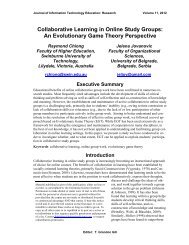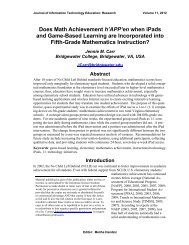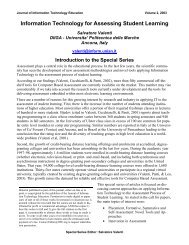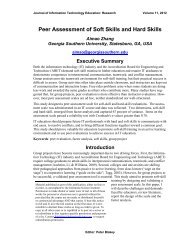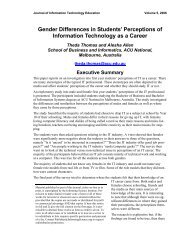Put Title Here Using Heading 1 Style - Journal of Information ...
Put Title Here Using Heading 1 Style - Journal of Information ...
Put Title Here Using Heading 1 Style - Journal of Information ...
Create successful ePaper yourself
Turn your PDF publications into a flip-book with our unique Google optimized e-Paper software.
Thomas, Davis, & Kazlauskas<br />
Bloom’s Revised Taxonomy and the Need for<br />
Metacognitive Skills<br />
The IS 2002 curriculum uses Bloom’s taxonomy in its recommendation for handling depth <strong>of</strong><br />
knowledge and higher-order thinking skills. As knowledge is moved from awareness through to<br />
advanced knowledge, Bloom’s levels <strong>of</strong> knowledge go from knowledge recognition, comprehension<br />
and application through to analysis, synthesis and evaluation. Table 1 is reproduced from the<br />
IS2002 curriculum and outlines activities that can be done at each level (Gorgone et al., 2002,<br />
p.39).<br />
Table 1: Knowledge levels, templates for objective writing and meaning <strong>of</strong> the depth levels<br />
with associated learning activities (Reproduced from Gorgone, et al., 2002, p.39)<br />
IS ’90, ’94, ’95, Blooms Levels <strong>of</strong> Template for writing behav- Meaning <strong>of</strong> depth <strong>of</strong> knowledge level and<br />
’97, 2002 Knowledge ioural objectives. Students activities associated with attaining that<br />
Depth <strong>of</strong><br />
Knowledge<br />
completing …. will be able to: level<br />
0 No Knowledge<br />
1 Awareness<br />
2 Literacy<br />
Strong Knowledge<br />
3 Concept / Use<br />
Skill<br />
4 Detailed<br />
understanding<br />
Application<br />
Ability<br />
5 Advanced<br />
1 Knowledge<br />
recognition<br />
1 Differentiation<br />
in context<br />
2 Comprehension,<br />
Translation,<br />
Extrapolation,<br />
Use <strong>of</strong><br />
knowledge<br />
3 Application<br />
Knowledge<br />
4 Analysis<br />
5 Synthesis<br />
6 Evaluation<br />
Define…<br />
List characteristics <strong>of</strong> …<br />
Name components <strong>of</strong> …<br />
Diagram…<br />
List advantages/disadvantages<br />
<strong>of</strong>…<br />
Compare and contrast …<br />
Explain …<br />
Write/execute simple …<br />
Define functional capabilities<br />
that are …<br />
Describe interrelations <strong>of</strong> … to<br />
related objects<br />
Use …<br />
Communicate the idea <strong>of</strong> …<br />
Form and relate the abstraction<br />
<strong>of</strong> … as …..<br />
Given a set <strong>of</strong> ….<br />
Interpolate/extrapolate to …..<br />
List concepts/major steps in …<br />
Search for correct solution to<br />
…<br />
And apply it to …<br />
Design and implement a … for<br />
…<br />
Write syntactically correct …<br />
and/or debug …<br />
Apply the principles <strong>of</strong> … to …<br />
Implement a … and maintain it<br />
…<br />
Develop/originate/institute…<br />
Construct/adapt…<br />
Generate novel solutions to …<br />
Come up with new knowledge<br />
regarding …<br />
Evaluate/judge the relative<br />
value <strong>of</strong> … with respect to …<br />
Introductory recall and recognition<br />
Class presentations, discussion groups,<br />
reading, watching videos, structure laboratories.<br />
Involves only recognition but with little<br />
ability to differentiate. Does not involve<br />
use.<br />
Knowledge <strong>of</strong> framework and contents<br />
Differential Knowledge<br />
Continued lecture and participative discussion,<br />
reading, team work and projects,<br />
structure labs. Requires recognition<br />
knowledge as a prerequisite. Requires<br />
practice. Does not involve use.<br />
Comprehension and ability to use knowledge<br />
when asked/prompted<br />
Requires continued lab and project participation,<br />
presentation involving giving<br />
explanations and demonstrations, accepting<br />
criticism; may require developing<br />
skills in directed labs.<br />
Selection <strong>of</strong> the Right Thing and <strong>Using</strong> It<br />
without Hints<br />
Semi-structured team-oriented labs where<br />
students generate their own solutions,<br />
make their own decisions, commit to and<br />
complete assignments, and present and<br />
explain solutions.<br />
Identification, Use and Evaluation <strong>of</strong><br />
New Knowledge<br />
An advanced level <strong>of</strong> knowledge for<br />
those very capable <strong>of</strong> applying existing<br />
knowledge in which denovo solutions are<br />
found and utilized in solving and evaluating<br />
the proposed new knowledge.<br />
329



